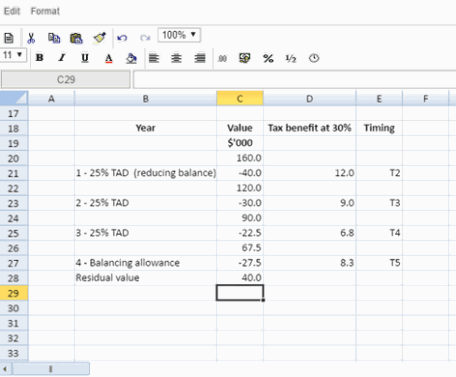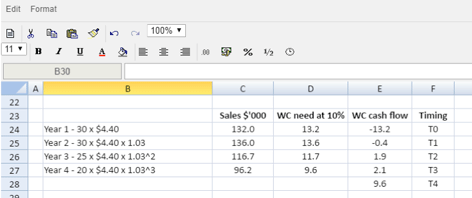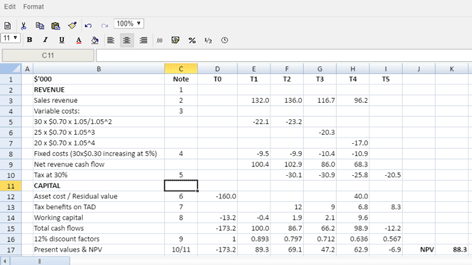Advanced investment appraisal
Investment appraisal is one of the core topics within Financial Management and it is a topic which has been well represented in the Financial Management exam.
Investment appraisal is one of the eight core topics within Financial Management and it is a topic which has been well represented in the exam. The methods of investment appraisal are payback, accounting rate of return and the discounted cash flow methods of net present value (NPV) and internal rate of return (IRR). For each of these methods students must ensure that they can define it, make the necessary calculations and discuss both the advantages and disadvantages.
The most important of these methods, both in the real world and in the exam, is NPV. A key issue in the Financial Management syllabus is that students start their studies with no knowledge of discounting but are very rapidly having to deal with relatively advanced NPV calculations which may include problems such as inflation, taxation, working capital and relevant/irrelevant cash flows. These advanced NPV or indeed IRR calculations have formed the basis for very many past exam questions.
The aim of this article is to briefly discuss these potential problem areas and then work a comprehensive example which builds them all in. Technically the example is probably harder than any exam question is likely to be. However, it demonstrates as many of the issues that students might face as is possible. Exam questions, on the other hand, will be in a scenario format and hence finding the information required may be more difficult than in the example shown.
The problem areas
Inflation
Students must be aware of the two different methods of dealing with inflation and when they should be used. The money method is where inflation is included in both the cash flow forecast and the discount rate used while the real method is where inflation is ignored in both the cash flow forecast and the discount rate. The money method should be used as soon as a question has cash flows inflating at different rates or where a question involves both tax and inflation. Because of this the money method is commonly required. Students must ensure that they can use the Fisher formula provided to calculate a money cost of capital or indeed a real cost of capital for discounting purposes. They must also be able to distinguish between a general inflation rate which will impact on the money cost of capital and potentially some cash flows and a specific inflation rate which only applies to particular cash flows.
Taxation
Building taxation into a discounted cash flow answer involves dealing with ‘the good the bad and the ugly’! The good news with taxation is that tax relief is often granted on the investment in assets which leads to tax saving cash flows. The bad news is that where a project makes net revenue cash inflows the tax authorities will want to take a share of them. The ugly issue is the timing of these cash flows as this is an area which often causes confusion.
Working capital
The key issue that must be remembered here is that an increase in working capital is a cash outflow. If a company needs to buy more inventories, for example, there will be a cash cost. Equally a decrease in working capital is a cash inflow. Hence at the end of a project when the working capital invested in that project is no longer required a cash inflow will arise. Students must recognise that it is the change in working capital that is the cash flow. There is often concern amongst students that the inventories purchased last year will have been sold and hence must be replaced. However, to the extent the items have been sold their cost will be reflected elsewhere in the cash flow table.
Relevant/irrelevant cashflows
This problem is rarely a big issue in Financial Management as students have been examined on this topic previously. However students should remember the ‘Golden Rule’ which states that to be included in a cash flow table an item must be a future, incremental cash flow. Irrelevant items to look out for are sunk costs such as amounts already spent on research and apportioned or allocated fixed costs. Equally all financing costs should be ignored as the cost of financing is accounted for in the discount rate used.
Fixed appraisal horizon
Sometimes directors of a company will only appraise projects across a set time horizon, which will not be the full length of the project and so does not include all of the cash flows. If a four-year time horizon is used, then the tax effects of the fourth year must be taken into account, even if tax is paid in arrears and the cash flows arise in the fifth year.
Having reminded you of the potential problem areas let us now consider a comprehensive example:
CBS Co
CBS Co is considering a new investment which would start immediately and last four years. The company has gathered the following information:
Asset cost – $160,000
Annual sales are expected to be 30,000 units in Years 1 and 2 and will then fall by 5,000 units per year in both Years 3 and 4. The selling price in first-year terms is expected to be $4.40 per unit and this is then expected to inflate by 3% per annum. The variable costs are expected to be $0.70 per unit in current terms and the incremental fixed costs in the first year are expected to be $0.30 per unit in current terms. Both of these costs are expected to inflate at 5% per annum.
The asset is expected to have a residual value (RV) of $40,000 in money terms.
The project will require working capital investment equal to 10% of the expected sales revenue. This investment must be in place at the start of each year.
Corporation tax is 30% per annum and is paid one year in arrears. 25% reducing balance writing-down allowances are available on the asset cost.
General inflation is 4% and the real cost of capital is 7.7%
$12,000 has already been spent on initial research.
Required: Calculate the NPV of the proposed investment.
Solution and explanatory notes:
Many students fall into the trap of starting the cash flow table too quickly. Initially there are a number of workings or ‘thinkings’ that should be carried out. These workings can generally be carried out in any order. Once they are completed it will be possible to construct the cash flow table quickly and accurately. Before going further students must understand the difference between a ‘T’ and a Year. A ‘T’ is a point in time and hence T0 is now and T1 is in one year’s time. A Year is a period of time and hence Year 1 is the period between T0 and T1 and Year 2 is the period between T1 and T2. Please note T1 is both the end of Year 1 and the start of Year 2.
Working 1 – Inflation
As the question involves both tax and inflation and has different inflation rates the money method must be used. Hence the cash flows in the cash flow table must be inflated and the discounting should then be carried out using a money cost of capital. As a money cost of capital is not given it must be calculated using the Fisher formula: (1 + i) = (1 + 0.077) x (1 + 0.04) = 1.12 Therefore, ‘i’ the money cost of capital is 0.12 or 12%
Note: The real rate (r) of 7.7% and the general inflation rate (h) of 4% must be expressed as decimals when using the Fisher formula.
Working 2 – Tax benefits on tax allowable depreciation (TAD)

The examiner’s normal assumption is that an asset is bought at the start of the first year of the project and, hence, the first TAD is available for Year 1.
The allowance and tax saving for Year 1 will be calculated at the end of Year 1 which is T1 and as tax is paid one year in arrears the timing of the cash flow will be one year later which is T2.
Rounding is a key technique in your exam as it saves time and by keeping the numbers simple fewer mistakes will be made. Here it has been decided to round in thousands and use one decimal place.
Students must ensure that they can calculate tax savings using different tax regimes. For instance the next problem you face may have tax allowances granted on a straight-line basis and the tax could be payable immediately at each year end.
Working 3 – Working capital (WC)

Notes:
As the investment in working capital is based on the expected sales revenue this has to be calculated first. Please note how the price per unit was given in first-year terms and hence that figure has been used for Year 1. In the following years the forecast inflation has been included. You should note the cumulative nature of inflation.
The working capital need is simply calculated as the stated % of sales revenue. When calculating the working capital cash flows it is the change in the working capital need which is the cash flow. Hence for Year 1 the need is 13.2 and as nothing has previously been invested the cash flow is an outflow of 13.2. In Year 2 the need has risen to 13.6 but as 13.2 has already been invested the cash flow is just an outflow of 0.4 – the increase in the need. In Years 3 and 4 the need decreases and hence cash inflows arise.
As the working capital is required at the start of each year the cash flow for Year 1 will occur at T0 and the cash flow for Year 2 will occur at T1, etc. Finally at the end of the project any remaining investment in working capital is no longer required and generates a further cash inflow at T4. The sum of the working capital cash flow column should total zero as anything invested is finally released and turns back into cash.
Other potential workings:
A working could be shown for the variable and fixed costs. However, this can be time consuming and enough detail can often be shown on the face of the cash flow table to show your marker what your thought process has been.
The $12,000 of initial research cost is ignored as it has already been spent. Hence it is a sunk cost and is not relevant to the analysis of the future project.
The cash flow table
Click to enlarge
It is estimated that the project has a positive NPV of $88,300 and hence it should be accepted as it will add to shareholder wealth.
Notes:
- A cash flow table should always be started on a new page as it will then hopefully fit on the one page. This avoids the need to transfer data over a page break which inevitably leads to errors. As tax is paid one year in arrears the cash flow table is taken to T5 even though it is only a four-year project. A cash flow table should be split into a ‘Revenue’ section and a ‘Capital’ section. In the ‘Revenue’ section all the taxable revenues and tax allowable costs are shown. In the ‘Capital’ section all the cash flows relating to the asset purchase and other cash flows which have no impact on tax are shown. Students should ensure that they put brackets around negative cash flows as otherwise negative items may be treated as if they are positive when the cash flows are totalled.
- The annual sales revenue figures are brought forward from Working 3. Note the normal assumption that the revenue for a year arises at the end of the year – hence the revenue for Year 1 is shown at T1. This assumption also applies to the variable and fixed costs.
- The variable costs for each year are based on the sales units for the year, the price per unit and the inflation rate for costs. Note that as the cost was given in current terms, which is as at T0 and the first costs are recorded at T1, the inflation has to be accounted for immediately. You should contrast this with the inflation of the sales revenue in Working 3.
- The fixed costs are relevant as they are said to be incremental. The cost per unit for the first year has been given and this is multiplied by the forecast sales in Year 1 to give the total incremental fixed costs. Like the variable costs the cost per unit was given in current terms and hence inflation must be accounted for immediately. From Year 1 onwards the fixed costs have continued to be inflated by the relevant inflation rate of 5%. You must remember that fixed costs are fixed and do not change as the activity level changes. In this way you will avoid the common error which is to treat the fixed costs as though they were variable.
- The tax is calculated at 30% of the net revenue cash flows. As tax is paid one year in arrears the tax for Year 1 which is calculated at the end of Year 1 (T1) will become a cash flow at T2. This pattern continues in the following years.
- The residual value was given in money terms and hence already reflects the impact of inflation. Had the value been given in current terms and no specific inflation rate was indicated then the logical approach would be to inflate at the general inflation rate. The normal assumption is that the asset is disposed of on the last day of the last year of the project and hence the cash inflow is shown at T4.
- The tax benefits on TAD are brought forward from Working 2. Please be careful to show them in the correct column given their respective timings. Also please remember that these are the ‘good news of tax’ and so are cash inflows.
- The working capital cash flows are brought forward from Working 3. They are shown in the ‘Capital’ section as they do not have any tax impact. If they were put in the ‘Revenue’ section they would change the net revenue cash flows and this would impact on the tax calculated which would be incorrect.
- The discount factors are found in the tables provided. The 12% rate is the suitable money cost of capital calculated in Working 1.
- The present values are found by multiplying the total net money cash flows by the discount factors shown.
- The NPV is simply the sum of the present values calculated. You should always comment on what the NPV calculated is indicating about the viability of the project.
As indicated previously this is a very comprehensive example which includes many of the major potential problems you could face. I would not expect any exam question to be as complex but all the problems shown in this example have been examined in the past and will I am sure be examined again in the future. Those most able to deal with these issues will be those who are most successful in the exam.


